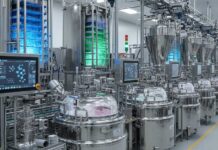It is still difficult to get to the bottom of viral illnesses. Although isolated medicines exist that block virus multiplication in human cells, they are a significant exception. Against this backdrop, Prof. Reinhard Klein’s from IMC Krems’ Department of Life Sciences’ research group members have now evaluated the potential of molecular technologies so as to control viral infections. The researchers employed a scientifically proven technology- CRISPR-Cas9 also known as gene scissors for targeted DNA alteration to massively lower adenovirus proliferation in human cell lines in cell culture.
This Nobel Prize-winning technology alters DNA segments in mammalian cells in a highly regulated manner. Prof. Klein notes that the goal was to investigate the possibilities of this technology for battling viral infections, such as adenovirus infections, which frequently cause disorders of the respiratory tract, digestive tract, and eyes. The idea here is to strike-off a portion of adenovirus DNA in infected human cell lines, preventing the viruses from reproducing.
As Prof. Klein says, the strategy was surprisingly successful, as they were able to reduce the number of infectious virus particles in human cell lines by up to three orders of magnitude under specific conditions. A result that verifies the method’s efficacy and reveals that this technology is also powerful enough to combat the vast number of viruses released in infected cells during some viral illnesses.
This accomplishment was due to the combination of various measures. The initial step was to choose the viral DNA sequence that would be targeted by the CRISPR-Cas9 system. The team chose the virus’s E1A section, which is particularly significant at the start of the viral replication cycle. Prof. Klein claims that by effectively stopping viral replication, researchers were able to keep the total amount of viral DNA in the cells low enough for the CRISPR-Cas9 system to function at all. The researchers were concerned about the probable amount of viral DNA in the cells at the start of the investigation. After all, if the viruses proliferated at a significant rate, the CRISPR-Cas9 system would simply surpass its limits. However, the inactivation of E1A, which is crucial for the massive increase of viral DNA in infected cells, prevented this.
The use of a variety of so-called guide RNA nucleic acid strands that allow targeting of the DNA target sequence was a second measure that contributed to the substantial inhibition of viral multiplication. As a result, the adenovirus E1A gene was silenced more effectively, increasing the possibility that the virus would be unable to multiply.
Even at low doses, a combination with the DNA synthesis-inhibiting medication Cidofovir improved viral replication inhibition. The amplification effect occurs when viral DNA replication is impeded at two separate levels: first, CRISPR-Cas9 reduces the quantity of functional E1A product in the cell, and then cidofovir inhibits any remaining viral DNA replication.
The findings of the widely acclaimed study at IMC Krems highlight CRISPR-Cas9’s broad applicability and the possibilities of employing the technology to inactivate viruses. A major future application against viral infections is thus theoretically possible. However, Prof. Klein adds that if this technique is to be used for the treatment of viral infections in the future, numerous other concerns must first be answered and technical barriers addressed. As a result, while an application is still a long way off, the theoretical possibility has been proven.



























